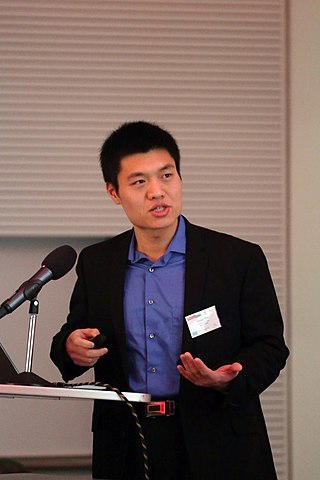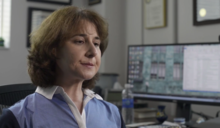
Sumio Iijima is a Japanese physicist and inventor, often cited as the inventor of carbon nanotubes. Although carbon nanotubes had been observed prior to his "invention", Iijima's 1991 paper generated unprecedented interest in the carbon nanostructures and has since fueled intense research in the area of nanotechnology.
Phaedon Avouris is a Greek chemical physicist and materials scientist. He is an IBM Fellow and was formerly the group leader for Nanometer Scale Science and Technology at the Thomas J. Watson Research Center in Yorktown Heights, New York.
Akhlesh Lakhtakia is Evan Pugh University Professor and Charles Godfrey Binder Professor of engineering science and mechanics at the Pennsylvania State University. His research focuses on electromagnetic fields in complex materials, such as sculptured thin films, chiral materials, bianisotropy and industrially scalable bioreplication, an emerging form of engineered biomimicry applied to harvesting of solar energy and pest eradication. His technique for visualization of latent fingerprints was covered in the NOVA documentary series "Forensics on Trial".

Lee Young-hee is a South Korean physicist. He is currently professor in physics and energy science at Sungkyunkwan University as a SKKU fellow. He is also director of the Center for Integrated Nanostructure Physics in the Institute for Basic Science (IBS). He has been a Clarivate Analytics Highly Cited Researcher in the cross-field category in 2018, 2019, and 2020.
Alan T. Charlie Johnson is an American physicist, professor of physics and astronomy at the University of Pennsylvania, and the director of the Nano/Bio Interface Center at the University of Pennsylvania.

Emily Ann Carter is the Gerhard R. Andlinger Professor in Energy and the Environment and a professor of mechanical and aerospace engineering, the Andlinger Center for Energy and the Environment, and the Program in Applied and Computational Mathematics at Princeton University. She has been on the faculty at Princeton since 2004, including as serving as Princeton's Dean of the School of Engineering and Applied Science from 2016 to 2019. She moved to UCLA to serve as executive vice chancellor and provost and a distinguished professor of chemical and biomolecular engineering, before returning to Princeton in December 2021. Carter is a theorist and computational scientist whose work combines quantum mechanics, solid-state physics, and applied mathematics.
Nadya Mason is the Rosalyn Sussman Yalow Professor of Physics at the University of Illinois at Urbana-Champaign. As a condensed matter experimentalist, she works on the quantum limits of low-dimensional systems. Mason is the Director of the Illinois Materials Research Science and Engineering Center (I-MRSEC) and, since September 2022, the Director of the Beckman Institute for Advanced Science and Technology. She is the first woman and woman of color to work as the director at the institute. In 2021, she was elected to the National Academy of Sciences.
Susan Trolier-McKinstry is an American materials scientist. She is the Steward S. Flaschen Professor of Materials Science and Engineering and Electrical Engineering at Pennsylvania State University, Director of the W. M. Keck Smart Materials Integration Laboratory, and co-director of the Nanofabrication facility.

Laura Gagliardi is an Italian theoretical and computational chemist and Richard and Kathy Leventhal Professor of Chemistry and Molecular Engineering at the University of Chicago. She is known for her work on the development of electronic structure methods and their use for understanding complex chemical systems.
Sharmila Mitra Mukhopadhyay is a professor of materials science and Director of the Center for Nanoscale Multifunctional Materials at Wright State University. In 2016 she was elected as a Jefferson Science Fellow, working as a science advisor to the United States Department of State.

Tabbetha A. Dobbins is an American physicist and an associate professor of Physics & Astronomy at Rowan University, where she also serves as the vice president for research. Her research investigates the relationship between structure and dynamics in composite materials using neutron and X-ray scattering with applications to modern engineering problems in carbon nanotubes, gold nanoparticles, the hydrogen fuel economy and polymer self-assembly.

Fengqi You is a professor and holds the Roxanne E. and Michael J. Zak Chair at Cornell University in the United States. His research focuses on systems engineering and data science. According to Google Scholar, his h-index is 77.

Joycelyn Harrison is an African-American engineer who is Associate Dean of the College of Aeronautics and Engineering at Kent State University. In 2006 she was awarded the NASA Outstanding Leadership Medal. Her research considers the development of novel piezoelectric materials.
Liu Ruozhuang was a Chinese physical chemist and academician of the Chinese Academy of Sciences (CAS). He was the founder of computational chemistry in China.
L. Catherine Brinson is an American materials scientist who is the Sharon C. and Harold L. Yoh, III Distinguished Professor at Duke University. Her research considers nanostructured polymers and shape-memory alloys. She was elected a Fellow of the American Association for the Advancement of Science in 2020.
André Taylor is an American scientist who is an associate professor of chemical engineering at the New York University Tandon School of Engineering. Taylor works on novel materials for energy conversion and storage. He was awarded the Presidential Early Career Award for Scientists and Engineers in 2010, and named as one of The Community of Scholars' Most Influential Black Researchers of 2020.

Douglas Henry Werner is an American scientist and engineer. He holds the John L. and Genevieve H. McCain Chair Professorship in the Penn State Department of Electrical Engineering and is the director of the Penn State University Computational Electromagnetics and Antennas Research Laboratory. Werner holds 20 patents and has over 1020 publications. He is the author/co-author of 7 books and 30 book chapters. According to Google Scholar, his h-index is 74 with more than 23,900 citations. He is internationally recognized for his expertise in electromagnetics, antenna design, optical metamaterials and metamaterial-enabled devices as well as for the development/application of inverse-design techniques.
Barbara Jane Garrison is an American chemist who is emeritus professor at Pennsylvania State University. She is the former Shapiro Professor of Chemistry and head of the department. She is a Fellow of the American Physical Society, American Chemical Society, American Association for the Advancement of Science and American Vacuum Society.
Linda Ellen Jones is an academic in the field of chemical engineering, and known for her work in high temperature chemistry. She is a professor at Western New England University and an elected fellow of the American Ceramic Society.
Elizabeth A. Holm, Richard F. and Eleanor A. Towner Professor of Engineering, is chair of the Department of Materials Science and Engineering, University of Michigan. Her research focus is computational materials. She worked at Sandia National Laboratories for 20 years before joining the faculty of Carnegie Mellon in 2012. She is a Fellow of The Minerals, Metals & Materials Society and Fellow of ASM International. She was the 2013 President of the society. She is internationally known for her theory and modeling work on microstructural response, interfaces, carbon nanotubes, and additive manufacturing.









